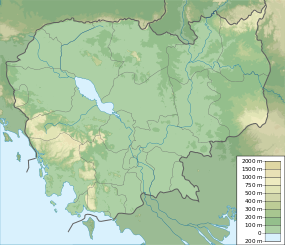Phum Snay
| ភូមិ ស្នាយ | |
| Location | Preah Neat Prey District, Banteay Meanchey Province, Cambodia |
|---|---|
| Region | Mekong Floodplain |
| Coordinates | 13°37′26″N 103°12′23″E / 13.62389°N 103.20639°ECoordinates: 13°37′26″N 103°12′23″E / 13.62389°N 103.20639°E |
| Type | Burial site |
| Area | 24 km2 (9.3 sq mi) |
| History | |
| Material | mound of rock, soil |
| Abandoned | around 1500 years BP |
| Periods | Bronze Age Iron Age |
| Cultures | Pre-Angkorian |
| Site notes | |
| Excavation dates | 2001, 2003, 2007 |
| Archaeologists | Dougald O’Reilly, Pheng Sitha and Thuy Chanthourn |
Phum Snay (Khmer: ភូមិ ស្នាយ) is an Iron Age archaeological site discovered in May 2000 in Preah Neat Prey District, Banteay Meanchey Province, Northwest Cambodia, around 80 km (50 mi) from the temple ruins of Angkor. The site was excavated between 2001 and 2003 by primary excavators Dougald O’Reilly of the Australian National University, Pheng Sitha and Thuy Chanthourn. The excavation was intended to discover more about Iron Age life in Cambodia.
The site was discovered in 2000 during roadworks, that linked Phum Snay village with National Road 6. Investigations revealed the presence of a number of ancient burials associated with material including bronzes and semiprecious stones. Immediate widespread looting by the local inhabitants over an area of 24 km2 (9 sq mi) made a full assessment of the extent of the archaeological remains difficult. Excavations started in February 2001 on a 15 x 5 m area.
The site dates roughly between 500 BC and AD 500. These dates were not obtained from stratigraphy as many of the artifacts and burials were disturbed by looting. Chronology was therefore determined by comparison to other nearby sites with similar grave goods and mortuary rituals.
A general analysis was done of the 134 individuals identified through the minimum number of individuals method. Twenty-one burials in total were exhumed that contained human remains. The researchers noted pathological lesions in photos and written descriptions. A few specimens were x-rayed but the images yielded limited results. The majority of the injuries listed were cranial lesions. These were categorized into two groups: those caused by sharp force trauma (henceforth referred to SFT) which left small focused circles or lines and those caused by blunt force trauma (BFT,) resulting in round depressions in the scalp. SFT lesions are generally caused by sharp edged weapons, such as knives, swords and axes. Projectiles, such as arrows or those used by a slingshot should also be considered as SFT objects or items. BFT lesions result from clubs, cudgels and hammers. Perimortem injuries were identified as separate from healed injuries because they often had bone flakes adhered to the edges of the fractures. Researchers were careful to distinguish between lesions caused by violence and those caused by infectious disease.
...
Wikipedia

